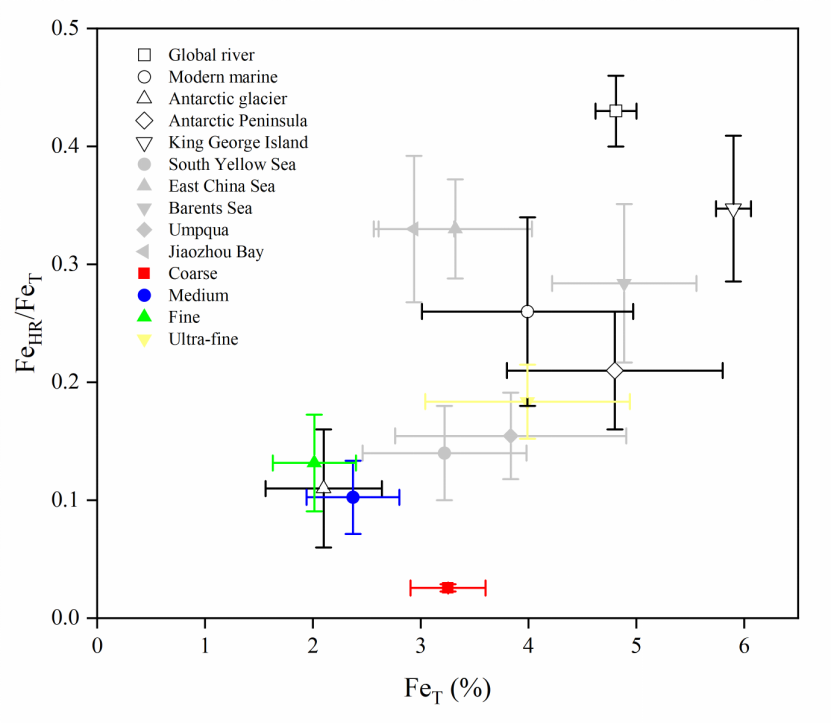Program
Recently, the Carbon Chemistry Research Team of the Key Laboratory of Marine Ecosystem Dynamics (MED) of the Second Institute of Oceanography, MNR, published the research paper entitled “Low content of highly reactive iron in sediments from Prydz Bay and the adjacent Southern Ocean: controlling factors and implications for sedimentary organic carbon preservation” in the oceanographic journal Frontiers in Marine Science. In this study, the surface sediment samples from Prydz Bay, East Antarctica, and adjacent oceans collected during the China Antarctic Scientific Expedition were applied to sequentially extract different phases of iron (Fe), measured total organic carbon (TOC), total iron (FeT), particle size and specific surface area, the distribution characteristics of Fe, especially active iron (FeHR) phases, were characterized, their controlling factors were discussed, and the relationship between TOC and FeHR was preliminarily explored from a global perspective. Huang Wenhao, a graduate student of Grade 2020 from the SIO, is the first author of the paper, and associate researcher Zhao Jun is the corresponding author.
Examining iron (Fe) speciation in marine sediments is critical to understand Fe and carbon biogeochemical cycling in polar regions. Due to its diverse mineralogy, crystallography, morphology and chemical composition, Fe exhibits significant redox and adsorption activity. Exploring Fe phase is the basis of Fe marine biogeochemistry. The research results show that the FeHR/FeT ratio in Priz Bay sediments is significantly lower than that of global river particulate matter and modern marine sediments, as well as that of other polar sediments. It also indicates that FeHR originates mainly from weakly weathered parent rocks in Antarctica, and the low rate of glaciers melting also limits FeHR input. The Feox1/FeT ratios are similar to those in continental shelf and marginal seas containing highly weathered materials, while the Feox2/FeT ratios are significantly lower. This result implicates that low temperature inhibits the aging of iceberg melting-sourced Feox1 potentially, and accordingly the regulation of weathering on the FeHR/FeT ratio is mainly reflected in Feox2/FeT ratio.
There are no significant correlations between TOC and FeHR phases, which is mainly attributed to the complex and diverse sedimentary environment in the study area. Four distinct patterns of TOC/FeHR ratio can be discerned by summarizing the global data set: (a) high TOC/FeHR ratios (> 2.5) are likely the result of high marine primary productivity and low chemically weathered source materials; (b) low TOC/FeHR ratios (< 0.6) are caused by high rates of FeHR inputs and TOC remineralization; (c) mid-range TOC/FeHR ratios (0.6 – 2.5) typical of most river particulates and marginal sea sediments indicate the same FeHR and OC sources and/or interactions between each other; (d) both low TOC and FeHR content is the result of low marine primary productivity and weak chemical weathering. The above findings provide new insights into the relationship between FeHR and TOC in ocean sediments: The TOC/FeHR ratio may roughly reflect the difference in the contribution of FeHR to TOC preservation in different sedimentary environments.
This research was jointly funded by the National Natural Science Foundation of China (41976228, 42276255, 41976227, 42176227), the Central Public-Interest Research Institute Basic Research Business Fee Special Fund (JG1805), the Southern Ocean Special Project “Impacts and Responses of the Antarctic Ocean to Climate Change” (IRASCC 01-01-02A and 02-02), and the China Scholarship Council Project (201704180017).

Figure 1 Schematic diagram of the relationship between FeT content and FeHR/FeT ratio in different rivers and marine sediments. The FeHR/FeT ratio in the surface sediments of the Prydz Bay and adjacent seas in Antarctica is significantly lower than that of global river particulate matter and modern marine sediments, as well as that of other polar sediments. This result indicates that FeHR in the sediment of the study area mainly originates from weakly weathered parent rocks in Antarctica, and the lower rate of glaciers melting also limits FeHR input.

Figure 2 Schematic diagram of the relationship between TOC content and FeHR content in marine sediments worldwide. The TOC/FeHR ratio in the surface sediments of the Prydz Bay and adjacent seas in Antarctica shows three different patterns. This finding provides new insights into the relationship between FeHR and TOC in marine sediments.
Paper Citation:
Huang W, Guo X, Zhao J, Li D, Hu J, Zhang H, Zhang C, Han Z, Sun W, Sun Y and Pan J (2023) Low content of highly reactive iron in sediments from Prydz Bay and the adjacent Southern Ocean:Controlling factors and implications for sedimentary organic carbon preservation. Front. Mar. Sci. 10:1142061. 1



